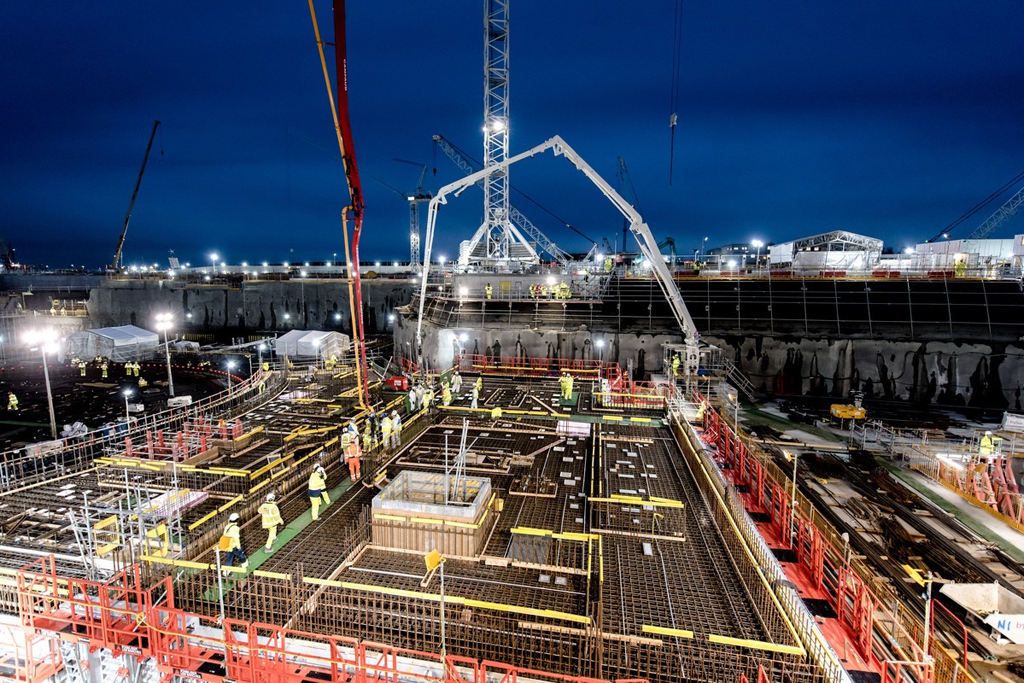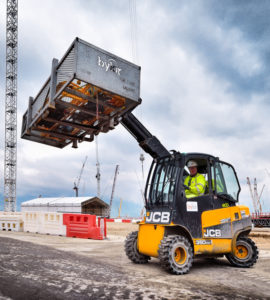JCB is playing its part in one of the largest civil engineering projects seen on our shores.
Major infrastructure projects require plenty of equipment, a massive quantity of materials and huge numbers of workers to complete. They also call for planning and logistics on a scale that would be unrecognisable to the majority of regular construction projects. Imagine a site canteen that has to serve more than 30,000 meals every day, for instance, with as much of that food as possible having been sourced from local suppliers within the surrounding community.
Or a park-and-ride bus service, that from start-up now runs one of the largest privately-owned coach fleets in the country, just to get workers in and out of the site each day. That is exactly what is needed to support the construction of Hinkley Point C (HPC), a new nuclear power station project in Northern Somerset.

HPC is the first new nuclear power station to be built in the UK for more than 20 years. The site is also one of the largest infrastructure construction projects seen in the UK for decades. With a build and commission time of almost 10 years and an overall cost of £19.6bn, HPC will provide secure low-carbon electricity for around six million homes, with its two nuclear reactors offsetting 600m tonnes of CO2 emissions over its 60-year lifespan.
Construction started in the second half of 2016 with unit 1 expected to be commissioned in 2025. Bylor – a joint venture between French company Bouygues Travaux Publics and UK construction giant Laing O’Rourke are delivering the main civils works, worth more than £2.8bn, constructing the buildings that will house the two European Pressurised Reactors and their associated facilities.
To get an idea of the numbers involved, Bylor will build 60 major structures over a seven-year period, employing 3,000 staff. The site will be home to 50 tower cranes and a further 20 crawler cranes, including the world’s largest land-based crane, the Sarens SGC250.
The fleet of 2,000 pieces of plant being used by Bylor comes under the control of general plant manager John McCoppin and his team. A seasoned Laing O’Rourke plant manager, McCoppin has worked for the company on sites from Abu Dhabi to Hong Kong. He handles the demands of keeping such a diverse fleet of equipment running, satisfying the needs of construction teams across the 40ha site, with remarkably calm assurance.

The Bylor plant fleet includes a number of JCB Loadall 540-140 telescopic handlers that provide essential lifting duties in the stocking areas and their delivery locations.
Materials and supplies are securely transported around the HPC site on large flatbed trailers, pulled by tractors.
John McCoppin said: “Our telehandlers do a lot more travel than they would on a conventional housebuilding site. We’re mainly using the machines as a forklift, but we also operate them with sweeper brushes.”
McCoppin is considering even larger, agricultural-specification Loadall models that can be provided with air brakes for the trailers, to improve productivity within the job site. He is also looking into rear view cameras, to further boost all-round visibility. The telehandlers were supplied as part of a growing fleet of the manufacturer’s machines by local dealer Holt JCB. With a free hand to purchase whatever equipment is required, the Loadalls were perhaps one of McCoppin’s easiest decisions.
John McCoppin added: “I’ve had JCB machines for more than 25 years now on sites around the world. The JCB telehandler is the market leader. It’s the most reliable and the easiest to maintain.”

Talking of which, Holt JCB will continue to service and look after the machines while under warranty, with Bylor taking over their care at the end of that period. Bylor has a fully equipped workshop on site, with a team of experienced engineers. The Loadalls are not the only JCB machines on the project. Bylor recently purchased a 457 wheeled loading shovel, for use in the batching plant; while a 1CX-T tracked compact backhoe loader has been called upon to work in confined access areas. There are several JCB site dumpers in use on various sections of the job and Bylor purchased two 714 articulated dump trucks to haul material within the project. Two 35D 4×4 Teletruk industrial telescopic fork lifts are also at work in the reinforcing steel preparation area.
McCoppin’s team operates as a service to the rest of the project, with the machine operators provided by the various sectors of the site. However, he does insist on having designated operators for each machine.
John McCoppin added: “We procure, maintain and supply the plant to the project. But we try to keep ownership of the Loadalls to a single operator. I am confident that with the way we maintain things and the reliability of JCB, these machines will see out this site and then possibly go on to the next one too.”
 One feature of the equipment that has proven particularly impressive, is the LiveLink telematics monitoring and tracking system that comes as standard on all JCB equipment.
One feature of the equipment that has proven particularly impressive, is the LiveLink telematics monitoring and tracking system that comes as standard on all JCB equipment.
John McCoppin said: “With LiveLink we can track the machine and see how it is being used. There are lots of really good things on LiveLink and now we can put the system on other machinery that we have too. We have 200 mobile access platforms here and we are looking at putting it on those as well,” said McCoppin.
The system provides fleet managers with real-time location and operational data; equipment alerts and allows managers to plan timely preventative maintenance. LiveLink also lets customers assess the effectiveness of their equipment fleet, showing how much the machinery is being used and allowing fleet controllers to move equipment between sites to achieve improved utilisation. Even within a single project, especially one of the size and scope of HPC, LiveLink allows McCoppin to assess the effectiveness of machine choice and to stay on top of regular service work.
Whatever your criteria, Hinkley Point C is an impressive construction project. With many of the UK’s power stations expected to close in the early 2020s, Hinkley Point C will be an essential element in the fight against climate change. For many workers on site, it will also have been a construction experience like no other.









